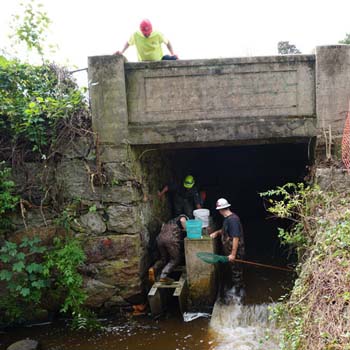
Holmes Dam removal site from above. Credit: Town of Plymouth
Holmes Dam Removal is Final Step in Town Brook Restoration
[dropcap]T[/dropcap]his September, the final major step in the nearly 16-year project to restore Plymouth, Massachusetts’ historic Town Brook began: the removal of the Holmes Dam. The project started in 2002, with the removal of the Billington Street Dam. Since then, new improved fishways were added to the Jenney Grist Mill and Newfield Street dams, the Water Street Dam was lowered by 12 inches (2004) and rock ramp constructed (2013), the Off-Billington Street Dam was removed (2013), and the Plymco Dam was removed (2014-15).
And now, the Holmes Dam is coming down, in time to complete just about the entire habitat restoration project by 2020, the 400th anniversary of the landing of the Pilgrims in Plymouth.
How It All Began
Nearly 400 years ago, the Mayflower came ashore near Plymouth Rock, a large boulder tucked deep into western shore of Cape Cod Bay. The protection offered by this harbor must have been attractive to the Pilgrims in mid-December of 1620. Graced with the “sweet water” of Town Brook, the Pilgrims chose this site to establish the first European colony in Massachusetts. What followed was a brutal winter, and the death of more than half of the original Pilgrims.
Silver Fish Were Key to Survival
The silver fish flowing up the little brook as river herring returned to spawn in the spring must have seemed a blessing to the surviving colonists. With the help of local knowledge shared by a native interpreter, the herring provided a rich source of fat and protein for the colonists. They also learned to use the herring as fertilizer for crops of corn and other produce. Months later, in a meal of thanksgiving for the harvest, eels migrating to the sea supplemented the crops and wild game on the first Thanksgiving table, and likely supplied the Pilgrims with dried and smoked fish for the winter. Without Town Brook, and its runs of diadromous fish, Plymouth Colony might not have succeeded.

Experts estimate that this run could support upwards of one million river herring. NOAA image.
Herring Play Important Role in Ecosystems
Today, as they did 400 years ago, river herring play a key role in riverine and oceanic ecosystems. River herring are sometimes called “forage fish,” as they provide food for predators, such as striped bass, bluefin tuna, bluefish, and Atlantic cod, that support valuable recreational and commercial fisheries. Whales, dolphins, seals, and all kinds of waterfowl also rely on these little silver fish for sustenance.
Archeology Plays a Role
As part of the project, state archaeologists excavated the site and found evidence of an old ironworks facility. Some of the found objects may be cleaned, restored, and added to the park. At a recent site visit, the state archeologist explained the history of the site.
Looking for Fish and Turtles

NOAA Fisheries and Town of Plymouth staff donned waders and headed into the underground river looking for fish and turtles to be evacuated before dam removal begins. NOAA image.
[information]
Questions?
Contact Jennifer Goebel at NOAA: 978-281-9175
[/information]

